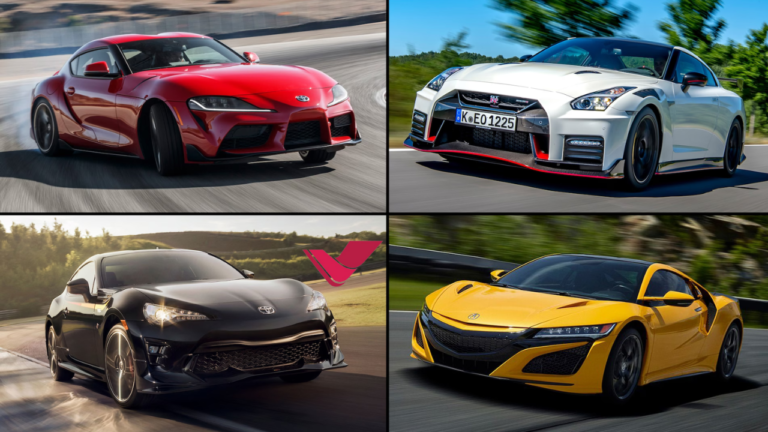Japan’s automotive industry has long been celebrated for its innovation, reliability, and unique design philosophy. Over the decades, the country has produced some of the most iconic vehicles, influencing car culture worldwide. This article delves into the realm of the coolest Japanese cars ever made, exploring their histories, features, and the reasons they’ve captured the hearts of car enthusiasts globally.
Pioneering Innovation: The 1960s and 1970s
Toyota 2000GT
The Toyota 2000GT launched in 1967, is often heralded as Japan’s first supercar. Its sleek, elongated design and high-performance capabilities marked a significant departure from the more practical vehicles Japan was known for. The 2000GT showcased a 2.0-liter inline-six engine capable of producing 150 horsepower, an impressive figure for its time. It wasn’t just its engine that made waves; the 2000GT’s design, with its low-slung silhouette and pop-up headlights, set a new standard for sports cars.
Datsun 240Z
Introduced in 1969, the Datsun 240Z (known as the Nissan Fairlady Z in Japan) revolutionized the sports car market. It offered a perfect blend of performance, style, and affordability. Equipped with a robust 2.4-liter inline-six engine, the 240Z could deliver 151 horsepower, enabling a top speed of over 125 mph. Its sleek design and reliable performance made it a favorite among car enthusiasts, and it played a pivotal role in establishing Japanese cars’ reputation in the global market.
Turbocharged Era: The 1980s and 1990s
Honda NSX
The 1990s brought us the Honda NSX (Acura NSX in North America), a car that redefined what a supercar could be. Honda aimed to combine supercar performance with everyday drivability, and the NSX was the result. Powered by a 3.0-liter V6 engine with VTEC (Variable Valve Timing and Lift Electronic Control), it offered an innovative approach to performance, focusing on overall balance and handling rather than just raw power. The NSX was also notable for its aluminum body, which helped reduce weight and improve performance.
Mazda RX-7
The Mazda RX-7, particularly its third generation launched in 1992, remains one of the most iconic Japanese sports cars, mainly due to its unique rotary engine. The RX-7’s 1.3-liter twin-turbo rotary engine was capable of producing up to 255 horsepower, offering a driving experience unlike any other. Its lightweight design and balanced weight distribution made it a favorite among driving enthusiasts, and it has maintained a cult following to this day.
Modern Marvels: The 2000s to Present
Nissan GT-R
No discussion of Japanese cars would be complete without mentioning the Nissan GT-R. Debuted in 2007, the GT-R, also known as “Godzilla,” was a technological marvel. It boasted a 3.8-liter twin-turbo V6 engine, capable of producing 478 horsepower initially, with newer models exceeding 600 horsepower. Its sophisticated all-wheel-drive system and advanced aerodynamics enabled it to compete with some of the best supercars in the world, often at a fraction of the price.
Toyota 86 and Subaru BRZ
Jointly developed by Toyota and Subaru, the Toyota 86 (and its twin, the Subaru BRZ), launched in 2012, reignited the passion for affordable, rear-wheel-drive sports cars. Powered by a 2.0-liter boxer engine, these cars were designed with a focus on balance and handling, providing a purist driving experience. While not the most powerful, their lightweight design and excellent weight distribution made them a favorite among driving enthusiasts, embodying the spirit of fun and accessibility.
The Influence of Japanese Car Culture
Japanese car culture has had a significant influence on the global automotive scene. From the customization scene epitomized by the “bosozoku” style to the precision and performance of “touge” mountain racing, Japan’s automotive enthusiasts have developed a unique and influential car culture. This culture not only celebrates the performance and aesthetics of cars but also fosters a sense of community and innovation among enthusiasts.
Conclusion
The coolest Japanese cars ever made are more than just machines; they are a testament to Japan’s innovative spirit, design excellence, and engineering prowess. From groundbreaking sports cars of the 60s and 70s to the technological marvels of the modern era, Japanese cars have consistently pushed the boundaries of what is possible. They have left an indelible mark on the automotive world, influencing car design, performance standards, and enthusiast culture globally. Whether it’s the raw power of the Nissan GT-R, the balanced performance of the Toyota 86 and Subaru BRZ, or the revolutionary design of the Toyota 2000GT and Datsun 240Z, these cars embody the spirit of Japanese innovation and continue to inspire car lovers around the world.
Read More: eplus4car: Revolutionizing Urban Mobility.


